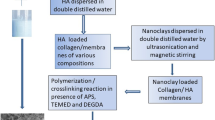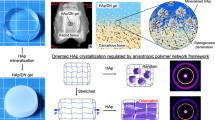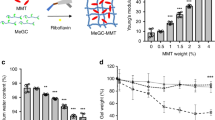Abstract
Collagen hydrogel systems have been limited in their uses for hard tissue engineering due to their poor mechanical properties in spite of their excellent biocompatibility. Physical strengthening and incorporation of the inorganic substances are considered as promising ways to improve mechanical stability of the collagen gel, while providing effective biomimetic environment for cells. Here, we developed three-dimensional matrix by rolling up the plastically-compressed collagen hydrogel composites with mesoporous bioactive glass nanoparticle (BGn). Monodispersed BGn with a size of ~90 nm was well incorporated within the collagen matrix which has nanofibrillar structure. The mechanical properties of the composite hydrogels measured by dynamic mechanical analysis were significantly improved by the compression of the hydrogels and further improved by addition of BGn into hydrogels. Moreover, the proliferation rate and osteogenic differentiation of rat bone marrow derived mesenchymal stem cells cultured within the composite hydrogels were enhanced by incorporation of BGn. The results suggest that physically-strengthened nanocomposite collagen hydrogel would be useful in hard tissue engineering applications.
Similar content being viewed by others
References
MG Patino, ME Neiders, S Andreana, et al., Collagen as an implantable material in medicine and dentistry, J Oral Implantol, 28, 220 (2002).
R Parenteau-Bareil, R Gauvin, F Berthod, Collagen-Based Biomaterials for Tissue Engineering Applications, Materials, 3, 1863 (2010).
DM Veríssimo, RFC Leitão, RA Ribeiro, et al., Polyanionic collagen membranes for guided tissue regeneration: Effect of progressive glutaraldehyde cross-linking on biocompatibility and degradation, Acta Biomater, 6, 4011 (2010).
D Becker, U Geißler, U Hempel, et al., Proliferation and differentiation of rat calvarial osteoblasts on type I collagencoated titanium alloy, J Biomed Mater Res, 59, 516 (2002).
SJ Kew, JH Gwynne, D Enea, et al., Regeneration and repair of tendon and ligament tissue using collagen fibre biomaterials, Acta Biomater, 7, 3237 (2011).
W Zhang, J Chen, J Tao, et al., The use of type 1 collagen scaffold containing stromal cell-derived factor-1 to create a matrix environment conducive to partial-thickness cartilage defects repair, Biomaterials, 34, 713 (2013).
EE Antoine, PP Vlachos, MN Rylander, Review of Collagen I Hydrogels for Bioengineered Tissue Microenvironments: Characterization of Mechanics, Structure, and Transport, Tissue Eng Part B Rev, 20, 683 (2014).
E Hesse, TE Hefferan, JE Tarara, et al., Collagen type I hydrogel allows migration, proliferation, and osteogenic differentiation of rat bone marrow stromal cells, J Biomed Mater Res A, 94, 442 (2010).
TR Hoare, DS Kohane, Hydrogels in drug delivery: Progress and challenges, Polymer, 49, 1993 (2008).
U Nöth, L Rackwitz, A Heymer, et al., Chondrogenic differentiation of human mesenchymal stem cells in collagen type I hydrogels, J Biomed Mater Res A, 83, 626 (2007).
BN Mason, A Starchenko, RM Williams, et al., Tuning threedimensional collagen matrix stiffness independently of collagen concentration modulates endothelial cell behavior, Acta Biomater, 9, 4635 (2013).
JH Lee, JY Lee, SH Yang, et al., Carbon nanotube–collagen three-dimensional culture of mesenchymal stem cells promotes expression of neural phenotypes and secretion of neurotrophic factors, Acta Biomater, 10, 4425 (2014).
GA Busby, MH Grant, SP MacKay, et al., Confined compression of collagen hydrogels, J Biomech, 46, 837 (2013).
RA Brown, M Wiseman, CB Chuo, et al., Ultrarapid Engineering of Biomimetic Materials and Tissues: Fabrication of Nano- and Microstructures by Plastic Compression, Adv Funct Mater, 15, 1762 (2005).
U Cheema, RA Brown, Rapid Fabrication of Living Tissue Models by Collagen Plastic Compression: Understanding Three-Dimensional Cell Matrix Repair In Vitro, Adv Wound Care, 2, 176 (2013).
F Laydi, R Rahouadj, G Cauchois, et al., Hydroxyapatite incorporated into collagen gels for mesenchymal stem cell culture, Biomed Mater Eng, 23, 311 (2013).
AK Gaharwar, SA Dammu, JM Canter, et al., Highly Extensible, Tough, and Elastomeric Nanocomposite Hydrogels from Poly(ethylene glycol) and Hydroxyapatite Nanoparticles, Biomacromolecules, 12, 1641 (2011).
JA Killion, S Kehoe, LM Geever, et al., Hydrogel/bioactive glass composites for bone regeneration applications: Synthesis and characterisation, Mater Sci Eng C Mater Biol Appl, 33, 4203 (2013).
A Gantar, LP da Silva, JM Oliveira, et al., Nanoparticulate bioactive-glass-reinforced gellan-gum hydrogels for bone-tissue engineering, Mater Sci Eng C Mater Biol Appl, 43, 27 (2014).
A El-Fiqi, T-H Kim, M Kim, et al., Capacity of mesoporous bioactive glass nanoparticles to deliver therapeutic molecules, Nanoscale, 4, 7475 (2012).
A El-Fiqi, JH Lee, EJ Lee, et al., Collagen hydrogels incorporated with surface-aminated mesoporous nanobioactive glass: Improvement of physicochemical stability and mechanical properties is effective for hard tissue engineering, Acta Biomater, 9, 9508 (2013).
S Labbaf, O Tsigkou, KH Müller, et al., Spherical bioactive glass particles and their interaction with human mesenchymal stem cells in vitro, Biomaterials, 32, 1010 (2011).
B Marelli, CE Ghezzi, D Mohn, et al., Accelerated mineralization of dense collagen-nano bioactive glass hybrid gels increases scaffold stiffness and regulates osteoblastic function, Biomaterials, 32, 8915 (2011).
T Kokubo, H Takadama, How useful is SBF in predicting in vivo bone bioactivity?, Biomaterials, 27, 2907 (2006).
DE Discher, P Janmey, YL Wang, Tissue Cells Feel and Respond to the Stiffness of Their Substrate, Science, 310, 1139 (2005).
T Yeung, PC Georges, LA Flanagan, et al., Effects of substrate stiffness on cell morphology, cytoskeletal structure, and adhesion, Cell Motil Cytoskeleton, 60, 24 (2005).
ND Evans, C Minelli, E Gentleman, et al., Substrate stiffness affects early differentiation events in embryonic stem cells, Eur Cell Mater, 18, 1 (2009).
LHHO Damink, PJ Dijkstra, MJA Van Luyn, et al., Glutaraldehyde as a crosslinking agent for collagen-based biomaterials, J Mater Sci Mater Med, 6, 460 (1995).
BP Chan, OC Chan, KF So, Effects of photochemical crosslinking on the microstructure of collagen and a feasibility study on controlled protein release, Acta Biomater, 4, 1627 (2008).
JM Orban, LB Wilson, JA Kofroth, et al., Crosslinking of collagen gels by transglutaminase, J Biomed Mater Res A, 68, 756 (2004).
MJA van Luyn, PB van Wachem, LO Damink, et al., Relations between in vitro cytotoxicity and crosslinked dermal sheep collagens, J Biomed Mater Res, 26, 1091 (1992).
CE Ghezzi, N Muja, B Marelli, et al., Real time responses of fibroblasts to plastically compressed fibrillar collagen hydrogels, Biomaterials, 32, 4761 (2011).
J Li, WRK Illeperuma, Z Suo, et al., Hybrid Hydrogels with Extremely High Stiffness and Toughness, ACS Macro Lett, 3, 520 (2014).
M Kikuchi, S Itoh, S Ichinose, et al., Self-organization mechanism in a bone-like hydroxyapatite/collagen nanocomposite synthesized in vitro and its biological reaction in vivo, Biomaterials, 22, 1705 (2001).
JE Aubin, Regulation of Osteoblast Formation and Function, Rev Endocr Metab Disord, 2, 81 (2001).
Author information
Authors and Affiliations
Corresponding author
Rights and permissions
About this article
Cite this article
Lee, J.H., El-Fiqi, A., Han, CM. et al. Physically-strengthened collagen bioactive nanocomposite gels for bone: A feasibility study. Tissue Eng Regen Med 12, 90–97 (2015). https://doi.org/10.1007/s13770-015-0102-7
Received:
Revised:
Accepted:
Published:
Issue Date:
DOI: https://doi.org/10.1007/s13770-015-0102-7




